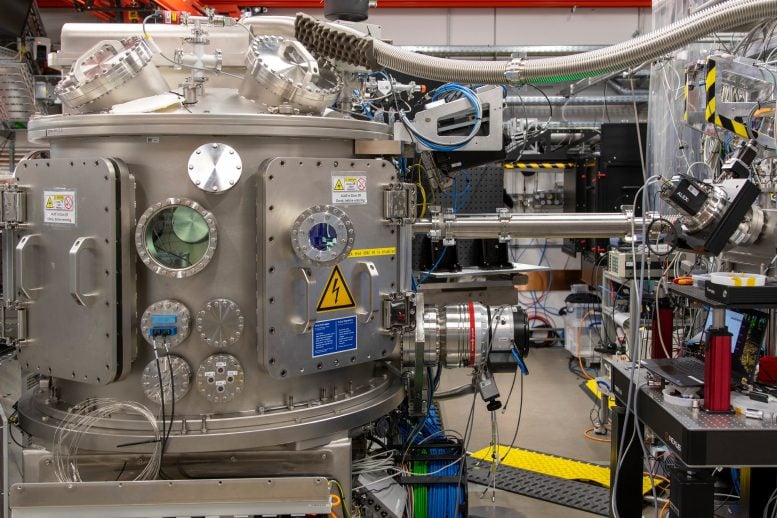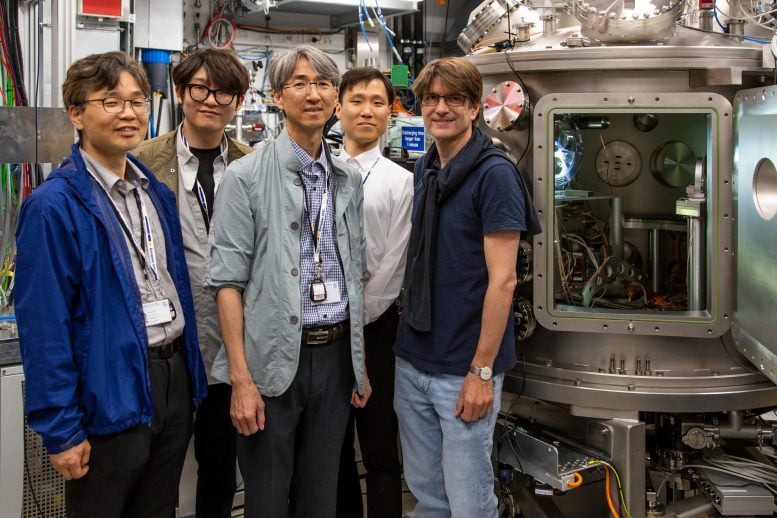Researchers from the European XFEL and DESY are studying unusual forms of ice that can exist at room temperature when subjected to extreme pressure.
Ice comes in many forms, even when it’s just made up of water molecules. Scientists have now identified more than 20 unique solid structures, or “phases” of ice, each with its own molecular arrangement. These variations are labeled with Roman numerals, such as ice I, ice II, and ice III.
In a recent breakthrough, an international team of researchers led by scientists from the Korea Research Institute of Standards and Sciences (KRISS) has discovered an entirely new phase known as ice XXI. Using the advanced X-ray facilities at Europe’s XFEL and PETRA III centers, the team captured and analyzed this previously unknown structure. Their findings were published in Natural materials.
Ice XXI is unlike any other ice form observed so far. It develops when liquid water is subjected to rapid compression, creating what scientists call “supercompressed water” at room temperature. This phase is metastable, meaning it can persist for some time even if another type of ice would normally be more stable under the same conditions. This discovery provides valuable new information about how ice behaves and transforms under extreme pressure.

The complexity of a simple molecule
Water or H2O, although composed of only two elements, exhibits remarkable complexity in the solid state. The majority of phases are observed at high pressures and low temperatures. The team learned more about how different phases of ice form and change with pressure.
“The rapid compression of water allows it to remain liquid until higher pressures, where it should have already crystallized into ice VI,” explains Geun Woo Lee, a scientist at KRISS. Ice VI is a particularly intriguing phase, believed to be present inside icy moons such as Titan and Ganymede. Its highly deformed structure can enable complex transition pathways leading to metastable ice phases.
Since most ice variants only exist in extreme conditions, the researchers created high-pressure conditions using diamond anvil cells. The sample – in this case, water – is placed between two diamonds which, due to their hardness, can be used to create very high pressure. The water was examined under pressures of up to two gigapascals, or about 20,000 times normal atmospheric pressure. This causes ice to form even at room temperature, but the molecules are much tighter than in normal ice.

To observe ice formation under different pressure conditions, the researchers first generated a high pressure of two gigapascals in 10 milliseconds (one millisecond is one thousandth of a second). They then released the cell from the anvil over a period of one second and then repeated the process. During these cycles, the team used the European XFEL’s X-ray flashes to capture images of the sample every microsecond, or one millionth of a second. With its extremely high rate of X-ray pulses – working like a high-speed camera – they could make films of how ice structure formed.
Crystallize the discovery
Then, using PETRA III’s P02.2 beamline, the researchers determined that Ice XXI has a tetragonal crystal structure made up of surprisingly large repeating units, called unit cells.
“Using unique X-ray pulses from the European XFEL, we discovered several crystallization pathways in H2O that was rapidly compressed and decompressed more than 1,000 times using a dynamic diamond anvil cell,” says Lee. “In this special pressure cell, samples are pressed between the tips of two opposing diamond anvils and can be compressed along a predefined pressure path,” says Cornelius Strohm of the DESY HIBEF team that implemented this setup on the high energy density (HED) instrument of the European XFEL.
“The structure in which the liquid H2“Oxygen crystallization depends on the degree of supercompression of the liquid,” Lee explains. “Our results suggest that a larger number of high-temperature metastable ice phases and their associated transition pathways may exist, potentially offering new insights into the composition of icy moons,” adds Rachel Husband from the DESY HIBEF team.
DESY and the European XFEL are making concerted efforts to better understand water: DESY through the joint effort Center for Molecular Water Science, and the European XFEL through its Water Call, from which this research was carried out. Sakura Pascarelli, Scientific Director of European
Reference: “Multiple pathways of freezing and melting of high-density ice through phase XXI of room-temperature ice” by Yun-Hee Lee, Jin Kyun Kim, Yong-Jae Kim, Minju Kim, Yong Chan Cho, Rachel J. Husband, Cornelius Strohm, Emma Ehrenreich-Petersen, Konstantin Glazyrin, Torsten Laurus, Heinz Graafsma, Robert PC Bauer, Felix Lehmkühler, Karen Appel, Zuzana Konôpková, Minxue Tang, Anand Prashant Dwivedi, Jolanta Sztuck-Dambietz, Lisa Randolph, Khachiwan Buakor, Oliver Humphries, Carsten Baehtz, Tobias Eklund, Lisa Katharina Mohrbach, Anshuman Mondal, Hauke Marquardt, Earl Francis O’Bannon, Katrin Amann-Winkel, Choong-Shik Yoo, Ulf Zastrau, Hanns-Peter Liermann, Hiroki Nada and Geun Woo Lee, October 10, 2025, Natural materials.
DOI: 10.1038/s41563-025-02364-x
Never miss a major breakthrough: join the SciTechDaily newsletter.
Follow us on Google, Discover and News.









